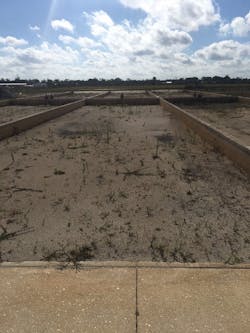Controlling Sludge Blanket Levels
Analytical Technology Inc.
800.959.0299
www.analyticaltechnology.com
The Punta Gorda Water Treatment Plant is a 10 mgd surface drinking water facility located just east of Punta Gorda, Florida. The process includes flocculation tanks, four solids contact units (SCUs) which are a form of upflow clarifier, filtration and disinfection.
ATI’s Entech EchoSmart sludge blanket monitors were used to control sludge levels in the SCUs. What began as an initiative to automatically control the sludge blanket level ended up producing unexpected benefits by significantly reducing the hydraulic loading to the drying process.
The flow of water in the SCUs is up through a blanket of sludge and into collection pipes which transport the settled water to the filters. The sludge blanket rises to a level where it cascades into a central trough, which runs the length of the SCU, from which the sludge is pumped to the drying process. As the water rises up through the sludge blanket, the blanket attracts particles in the water and acts as a filter, screening the solids and allowing the clean water to rise.
An EchoSmart self-cleaning sensor was installed in each of the four sludge troughs, and the signals were integrated into the plant SCADA to control the sludge pumps automatically. Self-cleaning sensors were required, which clear bubbles from the face of the sensor through use of a wiper.
The goal was to keep the sludge level in the troughs within a 6 to 8 inch range. Previously, the sludge pumps were turned on and off manually, which produced inconsistent results. If the pumps were inadvertently left on, they would deplete the sludge in the SCU, allowing unwanted solids to pass to the filters. If the pumps were left off, the sludge would build until the central trough was full, which would effectively shut down the SCU.
A grid of 12 cells comprise the drying beds, which have underdrains covered by 1 foot or more of sand. The sludge slurry is pumped onto the beds and the water percolates down into the underdrains for collection and treatment, and the remaining solids are allowed to dry.
The dried sludge is then collected and loaded onto trucks to be disposed of off site. Before the sludge level sensors were installed, a worker with a front end loader was managing the solids full time in all 12 cells. Large amounts of sand were needed to provide protection to the underdrains and filter the water.
After the blanket level sensors were installed, the sludge level was maintained within a 10-inch range from 35 to 45 inches. This reduced the hydraulic loading to the sludge drying train, to the extent that only one of the 12 cells was needed to dry the sludge. This consequently reduced the amount of sand needed, and allowed the employee to attend to other maintenance duties, rather than manage the drying process full time. It is estimated that the savings in sand alone was above $200,000.
